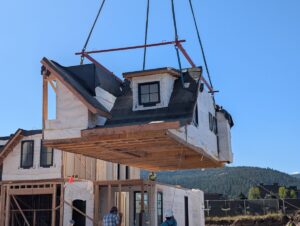The Affordable Housing Finance Fund (AHFF) is one of two funds that will receive a portion of Proposition 123’s approximately $300 million in funding, which is .1% of the state’s existing taxable income. If you’re looking to get into the nitty-gritty on the AHFF’s role in Colorado’s Proposition 123, you’re in the right place. As with anything that has to do with income tax from Coloradans, there’s a lot to sift through. EVstudio is here to help.
Of that approximate $300 million in funding, 60% (or about $180 million a year) goes to the AHFF, owned by Colorado’s Office of Economic Development and International Trade (OEDIT), but managed by Colorado Housing Finance Authority (CHFA). The other 40% goes to Affordable Housing Support Fund (AHSF), which is owned by the Division of Housing (DOH) but is managed by the Division of Local Government (DLG).
We’re going to break down the components of the AHFF, and how it relates to both private developers and non-profit organizations.
Affordable Housing Equity Fund (AHEF)
The AEF receives about 40-70% of the total AHHF funding, which equates to a range of $72-$126 million a year. This fund addresses rental projects up to 90% Average Median Income (AMI), with no variance for higher AMIs in rural or resort areas, which was a feature of previous DOH programs.
Rural Resort communities can petition for a higher AMI if a housing needs assessment demonstrates that, however. This applies to all aspects of AHFF funding, with the only catch being that the housing needs assessment has to have been done within the last five years.
Tenant Equity is part of the program. This means any tenant that resides for a year or longer is entitled to a share of equity growth for the property. This is to be paid for by proceeds from the equity fund itself, not from the project. Questions still need to be answered on how exactly that all will work. This equity is to be provided at below-market-rate cost of capital. The terms and sizing on that is yet to be determined. The AHEF is geared towards private developers.
Concessionary Debt Program (CDP)
The CDP accounts for 15-35% of the AHFF, putting this program’s funding in the $27-$45 million a year range. This offers debt financing to support low and moderate income multi-family rental projects, which is defined as 60% of the given area’s median income. The exception to that is where it is a secondary source of financing, matching income restrictions imposed by senior housing. Part of the debt is to preserve low-income properties while providing a gap-filler for Low Income Housing Tax Credits (LIHTC) projects in the form of subordinate debt and pre-development loans.
Debt financing to support new affordable housing will help preserve existing affordable multi-family rental housing will also be offered through the CDP. That comes along with debt financing offered to modular and factory-built housing manufacturers (such one of EVstudio’s partners, Fading West), although it’s unclear whether that’s to support Proposition 123-funded projects the manufacturers are working on, or general operations to support the influx of new work this funding may incur. The CDP is geared toward private developers.

Land Banking
Land banking funds account for 15-25% of the AHSF, totaling in the range of $27-$45 million a year. This facet of AHSF is available to local governments and nonprofits specifically. The land banking can be forgiven if certain conditions are met, with a plan required to be in place within five years, and development started within ten. A market rate component can be present in developments that utilize land banking through AHSF, but only if the predominant use is affordable housing. The affordable portion in that case must be at 60% AMI or lower to qualify.
What does this mean for my project?
If you’re looking for more information on Proposition 123, check out our main article on it here: What Proposition 123 Means for Affordable Housing
Our dedicated EVolution Design Studio is the only dedicated modular design studio at a multidisciplinary firm in the country. Through all we’ve learned by constantly pursuing the EVolution of the newest ideas, technologies, and opportunities, the EVolution Design Studio (or any of our Studios) would love to make your vision a reality. Let us know how we can help.









